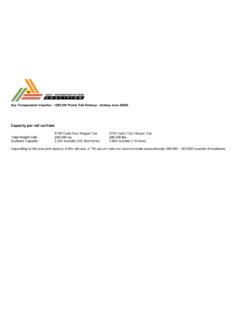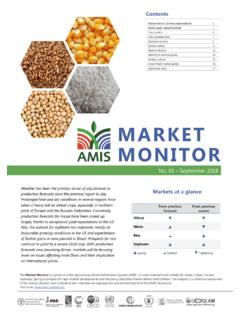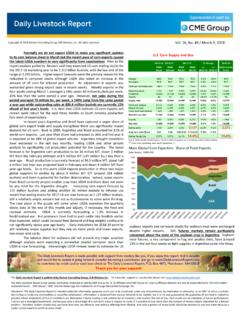Transcription of Soybean Supply and Demand Forecast - Soy …
1 Soybean Supply and Demand Forecast Soybean planted acreage is expected to increase million acres over the Forecast period. Soybean yields are expected to increase bushels per acre or an increase of 5%. Expected Soybean production increases are Forecast to exceed 463 million bushels over the Forecast period. Soybean crush and exports are expected to increase 280 million bushels and 282 million, respectively, from the baseline year of 2014 through to 2023. Soybean exports are driven by China's domestic crush industry. Soybean Products Soybean product Demand is driven by a combination of continued expansion in global protein Demand and a leveling off of distillers grains (DDGS) availability as the ethanol industry grows slowly after a decade of rapid growth. Canola meal continues to increase and displace domestic Soybean meal consumption. Meal Demand is the largest determinant of Soybean crush levels, since meal represents 80% of the volume of a bushel of soybeans (though a lower share of combined product value, as oil is more valuable on a per-pound basis).
2 Soybean oil usage is expected to increase billion pounds. Biodiesel usage is Forecast to increase 650 million pounds and food use is expected to increase billion pounds. Throughout the Forecast period, Soybean oil production will increase as domestic use and exports do the same. The will continue to be a large Soybean meal exporter. o Exports are Forecast to decrease by million short tons as animal numbers rebound. Domestic Soybean meal usage is expected to increase approximately million tons from million in 2014 to million in 2023. 1. Soybean Supply and Demand (million bushels). Source: USDA and Informa 2. Soybean Oil Supply and Demand (million pounds). Source: USDA and Informa 3. Soybean Meal Supply and Demand (thousand tons). Source: USDA and Informa 4. Major Importing Countries barley exports to any one country are less than 500 thousand MT. Sorghum exports to China have soared, but are expected to return to previous levels by the end of the Forecast .
3 Oat imports primarily come from the Netherlands and Canada. corn exports are largely shipped to Asia and Mexico. o The two largest importers are Japan and Mexico. Japan is a developed country with a declining population. Corn import levels are declining. o In crop year 2011, China has imported a significantly higher level of corn than in the last ten years. Since 2011, China has successfully limited imports of corn. Increasing corn imports are offsetting export declines in Japan and South Korea. China has shifted from not buying any corn to an acceptance that a minimum level of imports are necessary as long as they are not too dependent on one country. Informa believes China will accept a minimum level of corn imports as a necessity, but still attempt to remain nearly grain self-sufficient. o China does not want corn to become a trade negotiation tool. China still remembers the grain embargo of the former in the late 1970s. Once China's policy allowed Soybean imports, China's Soybean imports exploded and changed world trading patterns.
4 Soybean trade is dominated by China. o In crop year 2014/15, China accounted for 61% of Soybean exports. o China is also buying South American soybeans, which creates an export surge between the and South American harvest periods. China's buying of soybeans is continues to create optimism for other agricultural products, such as corn and pork. 5. Soybean Export Market Destinations 6. Soybean Meal Export Market Destinations 7. Soybean Oil Export Market Destinations 8. Soybean meal exports are largely shipped to Canada and Mexico. China corn acreage is expected to increase 5 million hectares at the expense of other crops, mostly cotton, in an attempt to remain grain self-sufficient. China domestic consumption of corn is continuing to increase as the population becomes wealthier and in turn, consumes more meat and processed products. o Pork is the main dish in China and the increasing price of pork is a major area of concern for the Chinese government.
5 China has chosen to grow the domestic pork industry, which requires an increase in corn imports. With more countries able to Supply China with corn, China is becoming more aggressive in importing corn. China does not want to be dependent on the for domestic food needs. Historically, China's policy was to develop markets to create jobs. For example, China imports soybeans and crushes them domestically instead of importing Soybean products. 9. China Corn Supply and Demand (thousand metric tons). Source: USDA and Informa 10. China's Soybean acreage is expected to remain steady. Due to China's large population, selling cooking oil locally has not been a problem. So, the level of crush is determined by Soybean meal Demand . As China's domestic consumption of meat increases and animal production switches from back yard to modern commercial animal operations, the Demand for Soybean meal has increased. The government has enacted policies that made importing the soybeans and crushing more attractive than importing Soybean products.
6 China's annual Soybean net imports have increased by 24 million MT from 2006 through 2010. From 2010 through 2023, Soybean annual net imports are expected to increase an additional 74 million MT to 126 million MT in 2023. 11. China Soybean Supply and Demand (thousand metric tons). Source: USDA and Informa Farm to Market: A Soybean 's Journey can be accessed at or Funded by the Soybean Checkoff 12.











